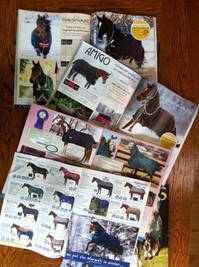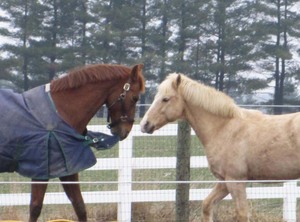To blanket or not blanket your horse - that is the question

Deluge of advertisements for horse blankets. Retailers would like to sell them; do you need to buy them?
Kathy Lundberg | Contributor
The north wind is picking up as the jet stream dips our way. Days are relentlessly getting shorter. The change in season excites the horses, making them more sprightly than in the languid summer months.
Night temperatures have started to dip toward freezing, and we know the winter will come. Will you blanket your horses this winter?
Horses may be blanketed to keep them warm, but realize that bundling up may be more of an irresistible human urge than a necessity for the horse. Horses have thicker skin, and most will grow a dense winter coat if allowed to acclimate to the changing weather.
Eating hay actually helps keep the horse warm in winter. Bacteria within the horse’s gut release heat as a byproduct of their own metabolism as they break down the structural carbohydrates in the fibrous vegetable matter within the horse’s large intestine. The horse’s large body mass dissipates heat more slowly than our own bodies do.
Some breeds are hardier, such as Shetland ponies, Fjord horses, Haflingers and draft breeds, having evolved in colder climates. Some individuals within a breed will be furrier than others.
As long as the horse has protection from wind and precipitation, and access to forage/hay, he can generally keep warm all winter without a blanket. The horse's blanket may actually flatten its body hair, preventing air entrapment between the hair shafts from insulating him.
A horse that is blanketed will grow less hair. For a horse that is worked throughout the winter, this is a benefit. “Rode hard and put away wet” is not healthy. A sweaty horse in a cold environment needs to be cooled down slowly so that its fur will dry before he can be turned back out in the pasture or stall, with or without a blanket.
A wool or fleece “cooling blanket” is generally applied to the steamy animal to prevent chilling. The process is quicker when there is not a long, drenched coat to evaporate. Some owners use an electric hair drier to speed the process. Some clip their horse’s hair very short so that the horse does not overheat when worked, and sweat will evaporate more efficiently.
Once the horse has been clipped, or has grown a less robust winter coat due to blanketing, the horse is dependent on its care takers to keep a functional blanket in place until warmer weather arrives. If that blanket tears, is shredded by pasture mates, develops a leak allowing water to seep through, becomes wet on a rainy 33 degree day, or any other misfortune occurs to that critical piece of horse clothing, the horse will be chilled until it is replaced. It is a good idea to have a spare blanket.
It takes more calories to keep an unblanketed horse warm than a well-insulated horse. Remember that a calorie is the unit of energy needed to raise one gram of water one degree Celsius. An unblanketed horse may eat more to keep warm. Simply put: buy a blanket or buy more food (costs are not equivalent!). Increased hay consumption is a good option under most conditions when free choice, quality hay is available.
Some horses have a hard time keeping weight on in winter even with abundant hay, as they simply cannot eat enough. Thoroughbreds, for example, are notorious for having high energy needs. Older horses may eat more slowly and may have trouble maintaining condition in winter.
Concentrated feed in addition to hay goes a long way toward meeting energy needs. Fat supplement either processed into the feed, or added as an oil top-dressing provides a caloric boost with less bulk. Blanketing in harsh weather can help these “hard keepers” hold on to their heat (energy) better.

Horse on left attempts to remove his blanket with help and encouragement from horse on right.
Kathy Lundberg | Contributor
There are a few other bothersome aspects to blanketing. Blankets are costly. Blankets with various amounts of insulation, quality of materials and snazziness of design cost from $100 - 400. You may need a light coat and a heavy one, and don’t forget the spare.
By spring, blankets are so dirty they practically stand by themselves and must be washed, waterproofed and repaired. Blankets often rub on shoulders and necks. You may need to purchase an undershirt for your horse to prevent raw blanket rubs. The Lycra undershirt may itself rub in different but just as bothersome places, or pull in unanticipated directions.
Straps come undone, break, and can get tangled. Horses may become startled due to tangled straps, slipping coats or while blankets are being placed or removed, causing harm to themselves or their handlers.
Blankets must be put on and taken off as the temperatures indicate. Boarders may drive barn managers insane with specific colored coats for specific narrow temperature ranges.
Blanketing can be a useful method of keeping your horse comfortable in the winter, especially if your horse remains in work through the cold months. To determine if blanketing is best for you, consider your riding goals, your horse’s individual characteristics, and the resources available to you to manage your horse’s clothing.
Kathy Lundberg is the owner of Scio Church Stables. Email her at scs@sciochurchstables.com.


Comments
julieswhimsies
Fri, Oct 14, 2011 : 7:21 p.m.
One more comment. If your horse is pastured with "bully" horses, who will not allow her in to the run-in, that is just cause for blanketing.
julieswhimsies
Sat, Oct 15, 2011 : 8:07 p.m.
At most well-run barns, horses are turned out with compatible horses. There are some people who believe that mares can only be pastured with mares. This is a very out-dated and unnatural idea. So. At these barns, if you are a mare, you are basically stuck with other mares, regardless of their temperament.
ypsicat
Sat, Oct 15, 2011 : 1:42 p.m.
For me, that would be just cause to find another pasture for my horse!
julieswhimsies
Thu, Oct 13, 2011 : 5:31 p.m.
My horse has spent winters with and without a blanket. Either way, she has done well. It should be noted that a "heavy" blanket is not the best choice for most horses. A medium weight blanket is all that is required. A lycra "undershirt" is also unnecessary. After your horse has been blanketed for a while you will discover where the blanket has caused "rubs". I simply apply a piece of "moleskin" (commonly used by runners) and stick it on the underside of the blanket where the rub occurred. Another important aspect is that the blanket have at least a 1200 count denier to it. The cheaper blankets with 600-800 count denier will be shredded in no time. A cooler is a nice thing to have, particularly in "transitional weather" like Spring and Fall...when the horse has developed her full coat and sweats a great deal....then gets chilled.
Trumpet
Thu, Oct 13, 2011 : 12:58 p.m.
I just had to smile while reading your informative article, as I was reminded of all the plusses and minuses of blanketing horses. Sometimes I realize that the horses have nicer winter clothing than I do, but isn't that typical for a horse person? Great article. I am going to print it and save it for my non-horse friends who always have questions about why horses need blankets, because "they don't need them in the wild".